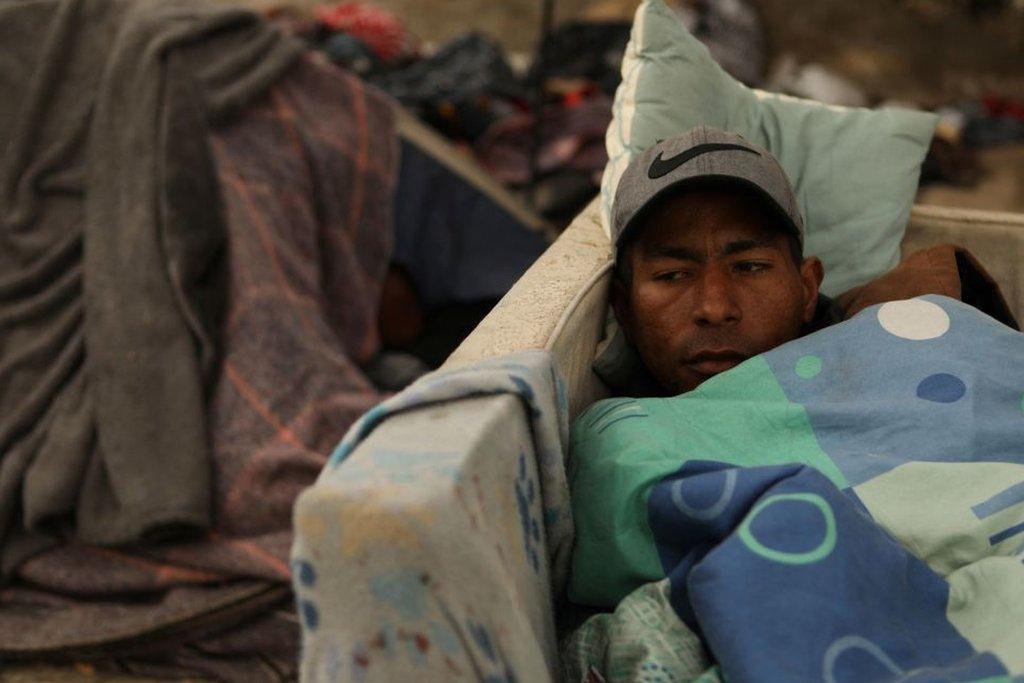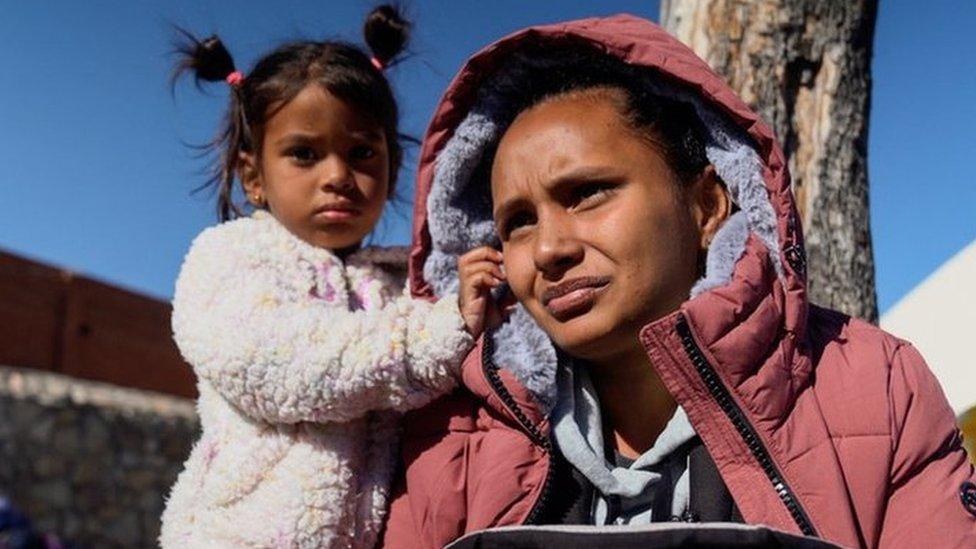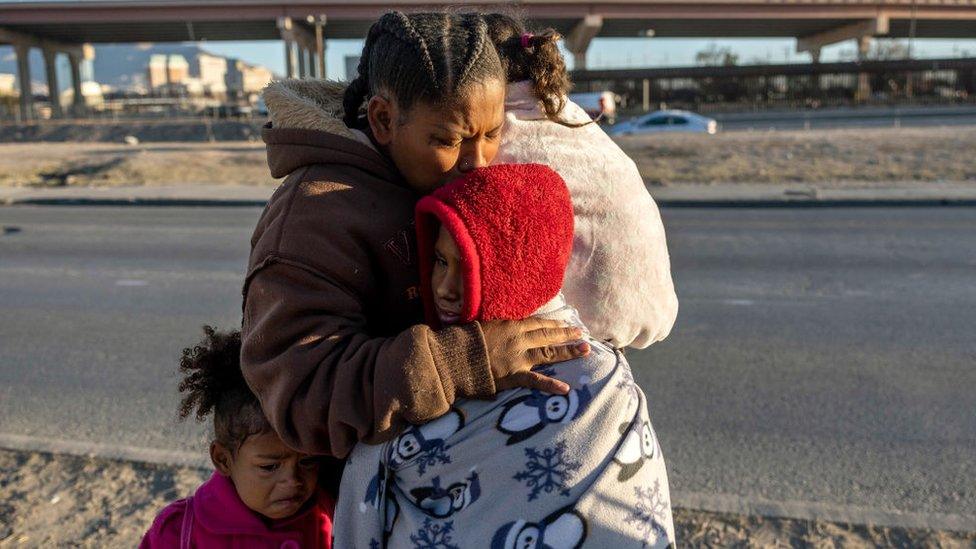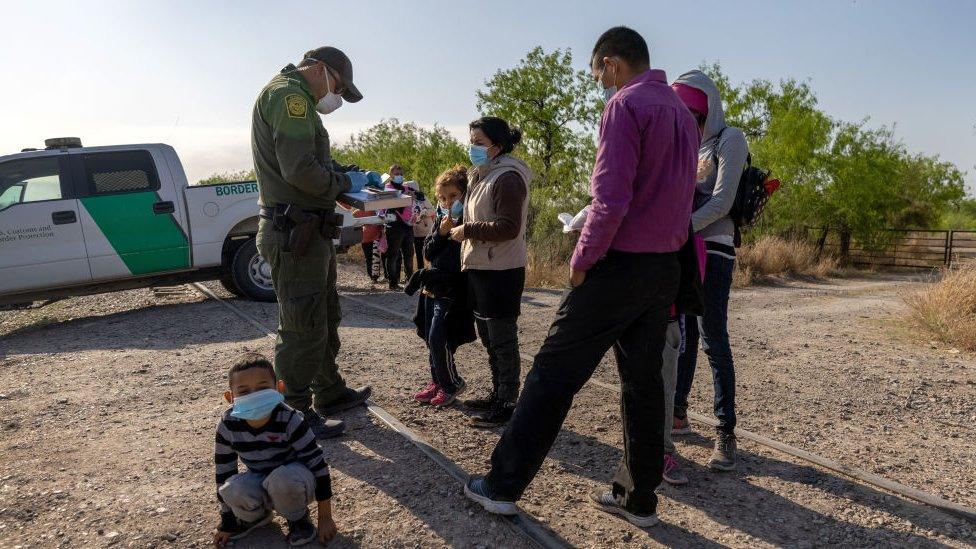Can Biden's new border plan end the migrant crisis?
- Published
Watch: Biden tells migrants 'don't just show up at the border'
US President Joe Biden has announced a new plan to accept up to 30,000 migrants each month, while also expanding a Trump-era policy to make it easier to send many back to Mexico. How will this impact the crisis at the border?
Mr Biden believes the new policy - which will apply to asylum seekers from Cuba, Nicaragua, Haiti and Venezuela - will "substantially reduce" the number of people who attempt to cross the US-Mexico border illegally.
"This new process is orderly, it's safe and it's humane," Mr Biden said in a speech at the White House.
While experts and immigration advocates believe it may be effective, many expressed concerns that an increased number of migrants may be sent to unsafe or inhumane conditions in Mexico.
"The administration is shifting its overall policy to a carrot and stick approach," said Aaron Reichlin-Melnick, of the American Immigration Council. "And the emphasis is on the stick".
What's in the new plan?
Citizens from the four countries will be offered an expanded legal pathway to apply to enter the US, where they will be allowed to live and work for up to two years. To be eligible, migrants must have financial sponsors already in the US, and pass security vetting.
Applications can be done through an application, CBP One, which allows would-be asylum seekers to schedule an arrival at a port of entry into the US. Those who are denied or attempt to cross illegally will be ineligible for the programme in the future.
"Stay where you are and apply legally. If your application is approved...you have access," Mr Biden said on Thursday. "But if your application is denied or you attempt to cross into the United States unlawfully, you will not be allowed to enter."
US officials say that migrants who do attempt to cross the border illegally will rapidly be sent back to Mexico under Title 42, which gives the government power to automatically expel undocumented migrants seeking entry, with Mexico agreeing to 30,000 more returns each year.
Previously, Mexico's government only accepted the return of its own citizens under Title 42, along with citizens of Guatemala, Honduras and El Salvador. In October, the programme was expanded to include Venezuelans.
US officials said that the previous initiative led to a 90% drop in the number of Venezuelans arriving at the US-Mexico border, and a "dramatic" drop in the number of migrants who choose to risk their lives by using human smugglers.

More than 2.5 million migrants have been expelled under Title 42 since 2020.
Can Biden's new plan work?
Record number of migrant detentions at the US-Mexico border have presented a growing political headache for Mr Biden. More than two million people were detained at the order in the 2022 fiscal year that ended on 30 September - a 24% jump from the previous year. In December, detentions at the border averaged between 700 and 1,000 each day.
Mr Reichlin-Melnick told the BBC that he believes the creation of alternate pathways is a "positive step" - albeit one that represents a "real return to the Trump-era policies that attempted to deter asylum seekers from getting here in the first place."
He said there could be a drastic reduction in the number of apprehensions at the border, especially among Cubans and Nicaraguans, but he warned that could be offset by migration flows from elsewhere.
Rebecca Solloa, from the Catholic Charities at the Diocese of Laredo - which operates migrant shelters at the border - told the BBC the new application process would slow the influx of migrants. "If it's in an orderly manner, it will help them in the long run and it won't be such a crisis," she said.
But the process has to be credible to stop migrants considering an illegal border crossing, said Andrew Selee of the nonpartisan Migration Policy Institute.
"If the legal pathways aren't effective, and the only consequences are being dropped back in a Mexican border town, and you're a Nicaraguan trying to get out of Nicaragua, there's still a good incentive to try and cross multiple times until you make it."
Some advocates are also concerned that the application process may be difficult for some to access in remote or impoverished areas of their home countries, or that potential migrants may not be aware of it before they leave.
Safety concerns in Mexico
The success of the programme ultimately will rest on Mexico's ability to take care of the migrants it has now agreed to take back.
"Northern Mexico is a dangerous place for migrants," Mr Reichlin-Melnick said. "We know that this will strand some of the most vulnerable people in the world in Mexico with few good options for ever being able to seek safety in the United States."
In the short-term, he believes that the border region will see new migrant encampments at the border as migrants already there weigh their options, as well as "potentially significant anger and unrest as migrants wait to see what happens next."
The announcement comes a day after Mr Biden said he would visit the border next week on his way to Mexico, where he will participate in the North American Leaders' Summit.
Watch: No tree or gifts for thousands in this US city this Christmas.
Related topics
- Published27 December 2022

- Published23 December 2022

- Published21 December 2022

- Published12 December 2022
